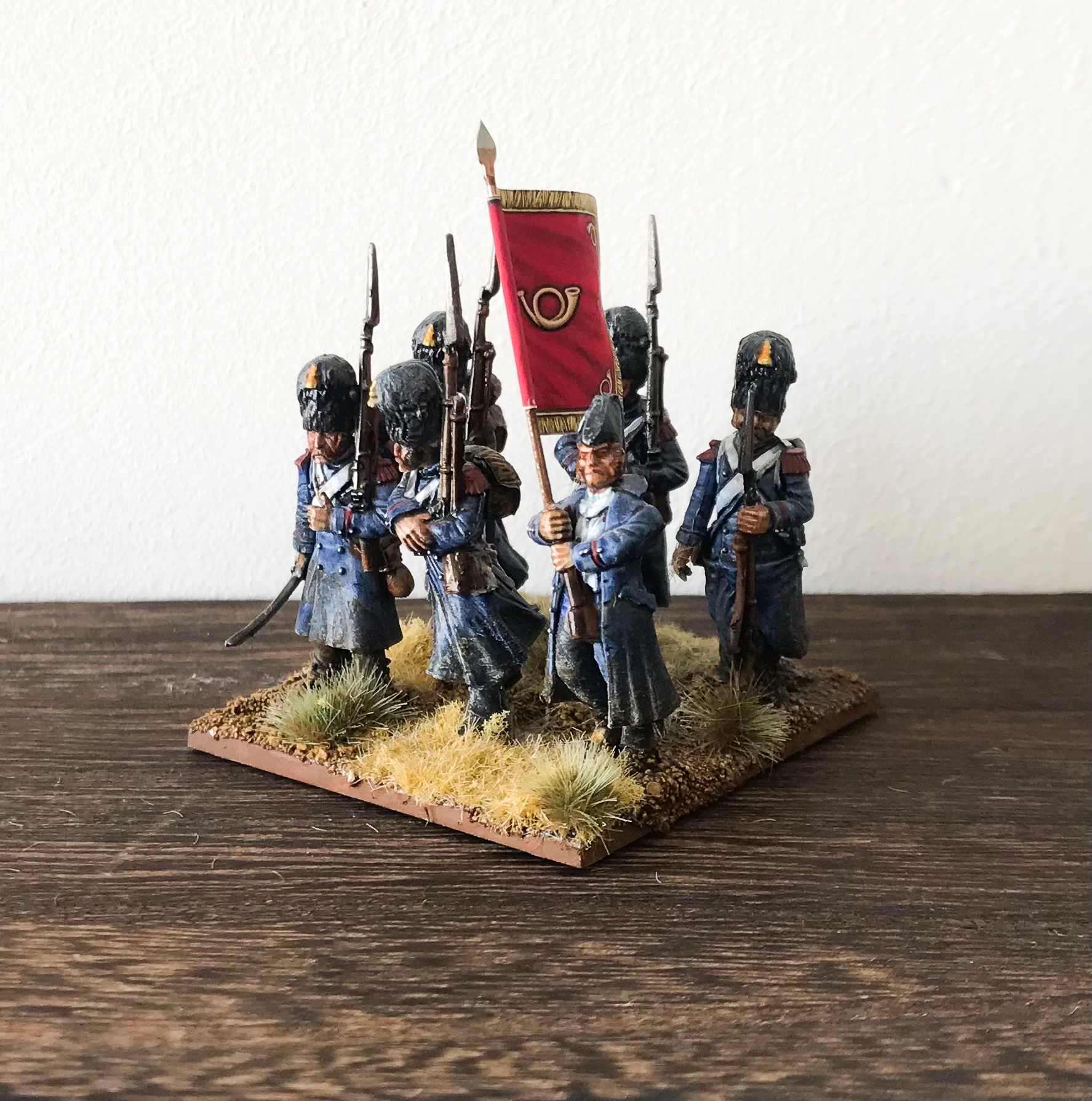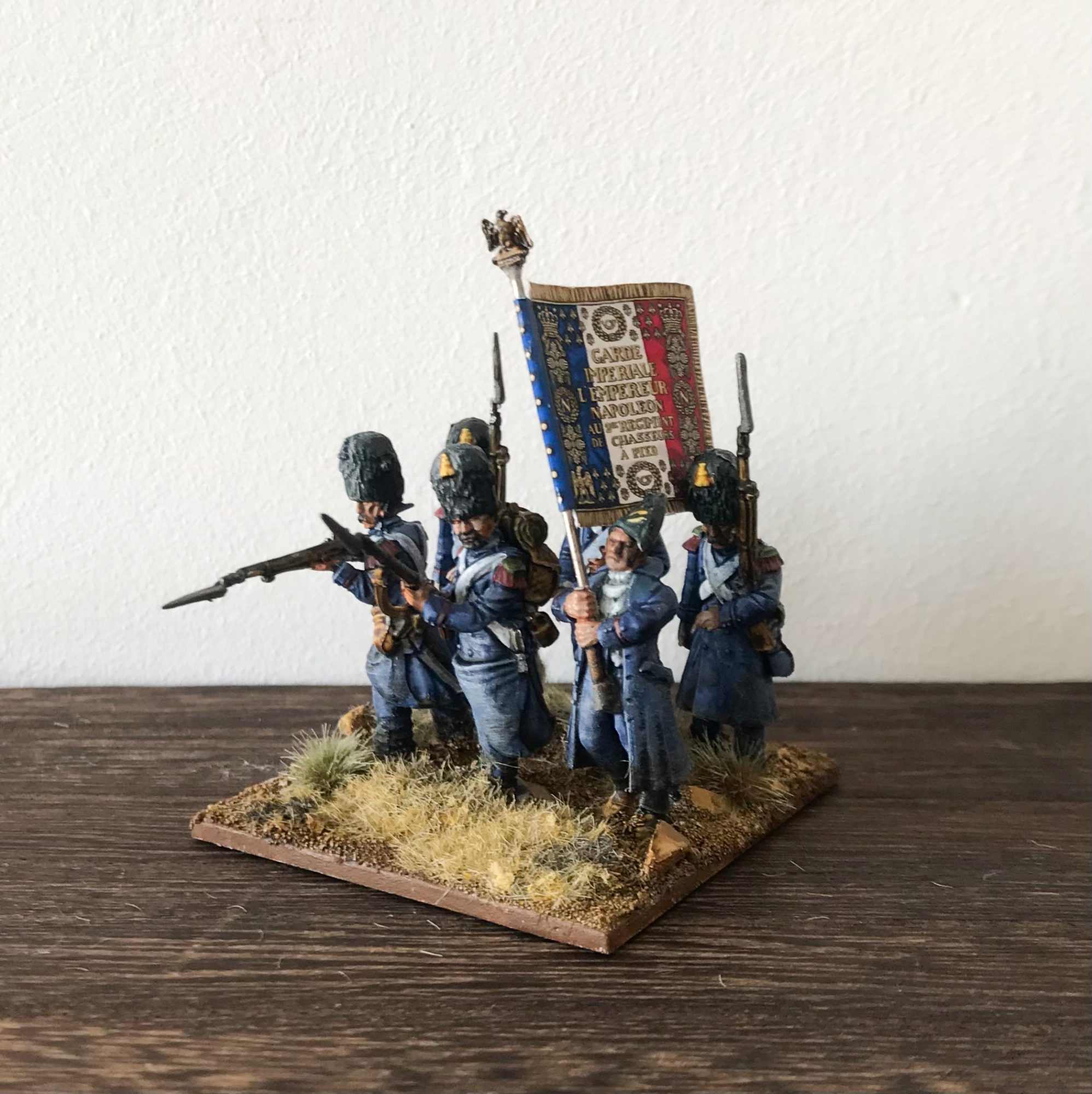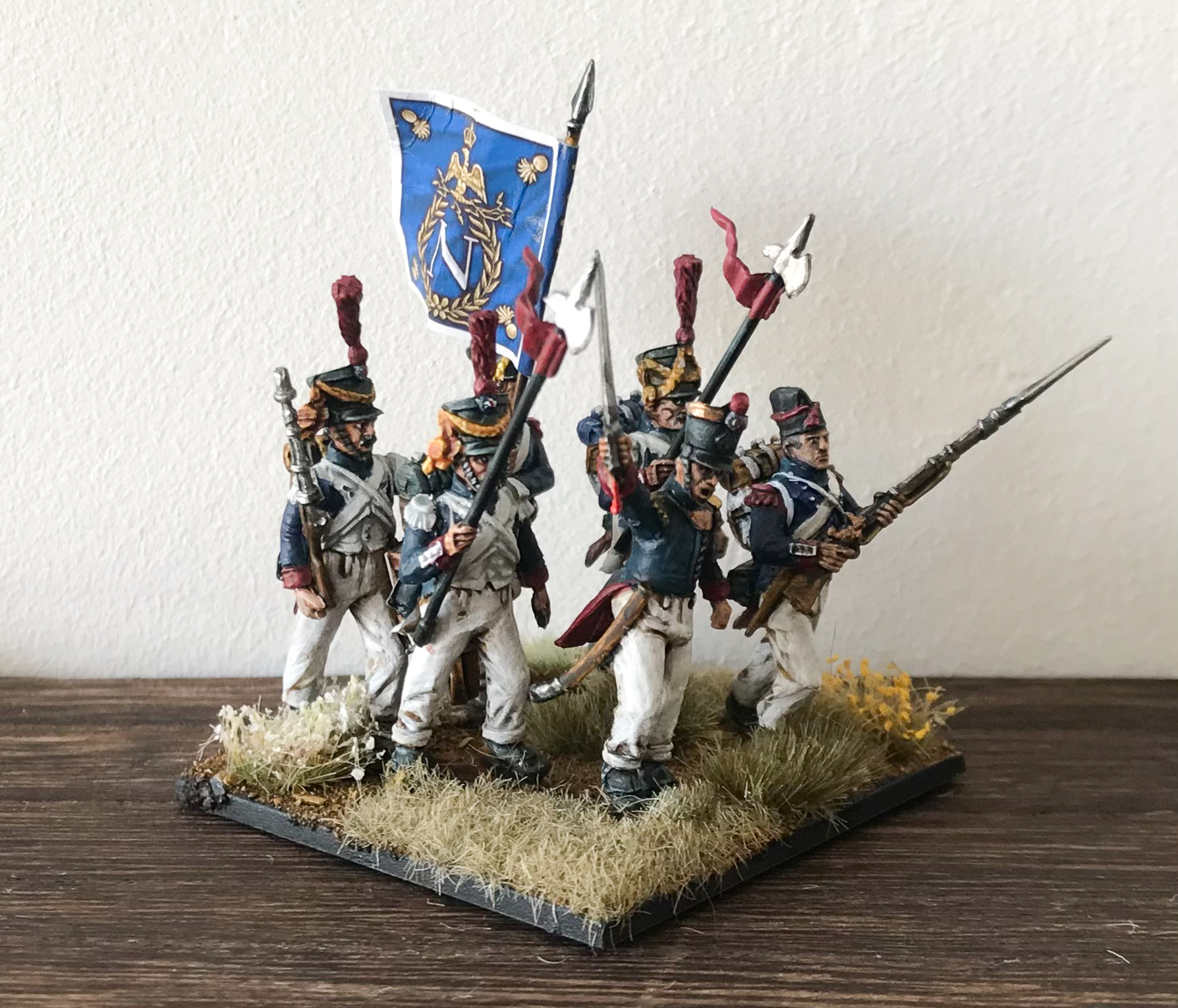I got to a point last article when I felt: I’ve got this. I know what I’m doing, I more or less know the history, and I know the games and the plan. You might have noticed the smug tone of the previous article – three units fully completed, another two in the bag but needing some touch ups, command figures done, a variety of base types and sizes and all that, even some cavalry slowly gathering paint on their accursed horses. Then an innocently asked question completely threw that to shit.
After three months of doing this, it turns out I still know bugger all, or as the french might put it j’entrave que dalle. This article is an attempt to get all this sorted in my own head, so buckle up and strap yourselves in for fanions, flags, flanks and one fucking awkward question:
What is a battalion?
I’d been showing off my painted guys so far, and just throwing “battalion” in there as a bit of mega-brain technical jargon. “The row at the back is a battalion of Old Guard, the second and third rows are battalions of Middle Guard (yes, I did another 30-man unit), and the guys at the front are the beginning of a battalion of Young Guard”. The Guard bit is pretty self explanatory: Young, not-young and Old, but the battalion bit ends up being quite specialist knowledge, and I realised I didn’t have a good explanation. I’ve been using it as a substitute for “unit”, because the last ranked up game I played a lot of was Warhammer fantasy, where every 2-30 men gets a command group and they’re called a unit, no more complicated than that.
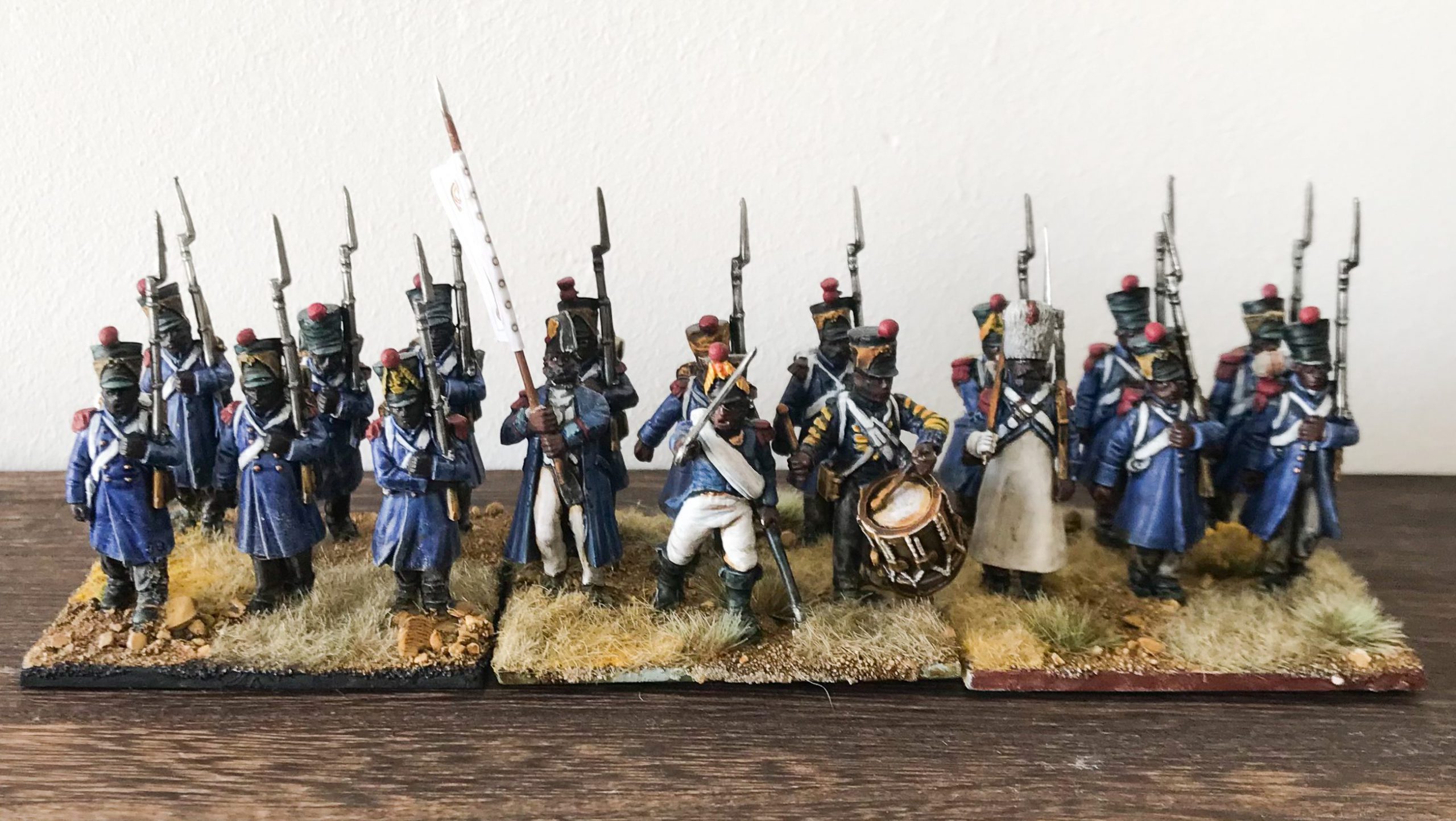
Confusingly, depending on the wargame, this basic unit can be “a battalion”, “a section”, “a company” and even “a regiment”. Whatever they’re called, and whatever the size, this basic “unit” is the staple of the mass battle game at most scales I’ve looked into. It might have 30 men at 28mm, 40 in 15mm, or 60 in 3mm, but that’s a unit with a flag, a drummer, an officer and it is pretty much just what I used to use in Warhammer, except they’re 19th century French rather than the all-Goblin, all-losing horde I played through my 20s with.
One of the conceits of many wargames is that one figure stands for many there “in reality”. It’s our way of labelling games so that everything we do isn’t on the scale of large bar brawl. Yes, there’s 100 bugs and 23 whatever the big golden men are called on the table right now, but this is part of the epic battle of Inania LXIX where the entire 14th maniple fought off the hive-swarm. The guys on the table are your guys but we know the shorthand – we can’t play the battles 1 for 1, or every game would be multi-day slogs. Historical players know this – and suffer it – more than most, especially at 28mm.
So what does a tabletop batallion represent? Now for someone who knows a lot about the Napoleonic period, that probably isn’t a difficult question. Unfortunately, contrary to my own opinion, in reality I’m not there yet. Napoleonic battles were huge, making even relatively minor clashes impossible to play out at 1 model = 1 man so we all accept that yeah that unit of 20 guys really IS the 5eme regiment du ligne, and this 30-person organised chaos mega battle IS Waterloo, despite the fact we’ve only got 1,000 models on the table and the impersonator we hired to be Wellington is really sub-par and kind of bigoted.
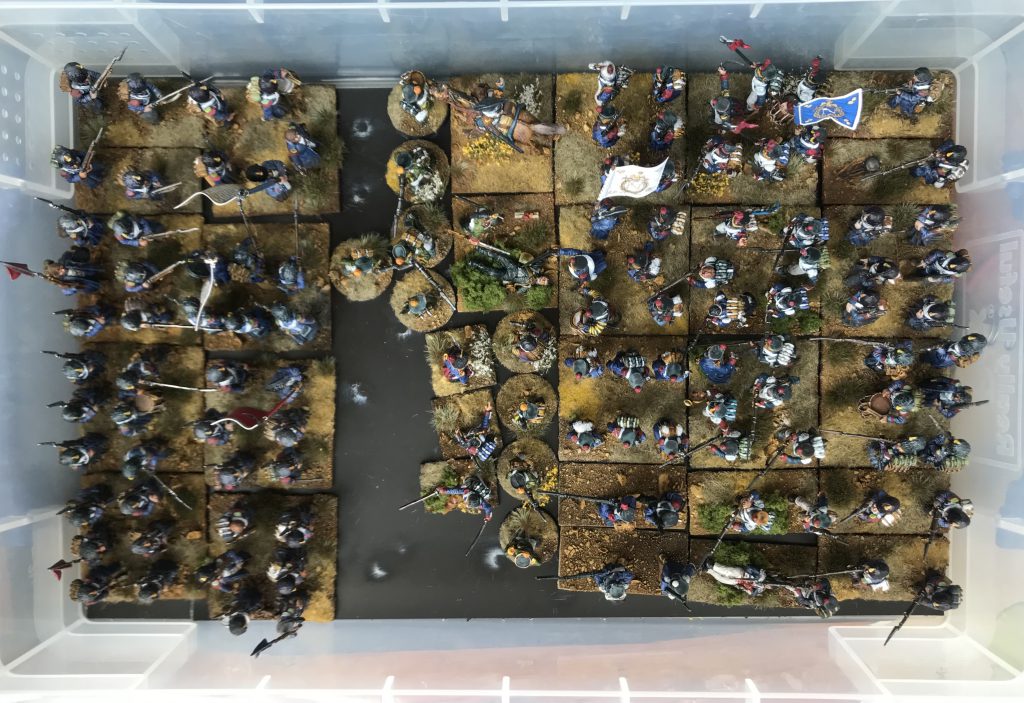
Ok I got distracted then. Where was I?
Ah yeah. The historical battalion – turns out, way, way bigger than I thought. Much, much bigger. I thought maybe I was looking at 1:10, so I could go to a smaller scale and field full battalions, or even work towards a 1 to 1 battalion (with extra flags). No. Definitely, by far, not. The most common organisation scheme for infantry in the Grande Armee is order of magnitudes larger than I thoug
| Unit type | Organisation | Number | Command |
| Section | 60ish privates, 10 NCOs/Officers/Others | 70 men | Sub-Lieutenant |
| Company | 2 sections, NCOs and Officers | ~130 men | |
| Battalion | 6 Companies, Senior NCOs, Officers | 400-800 men | Chef d’battalion |
| Regiment | 4 Battalions, Regimental command and non-combatants | 2-4,000 | Colonel |
| Brigade | Two regiments | General de brigade | |
| Division | 2-3 brigades, with cavalry and artillery | 4-10,000 | General de division |
| Corps | Several divisions | 10-80,000 | Marshals |
| Entire Goddamn French Army | Whatever Napoleon wanted it to be | 600,000+ | Napoleon |
When you actually look at the sizes of these things, it’s absolute nonsense to even think about one of my (or indeed anyone’s) 28mm units as being “a battalion” or “a Regiment”, but I’m happy calling them companies and sections. Within a section, you also had a peloton an aggressively marketed running/cycling thing that I personally just don’t understand the appeal of a tactical unit based around smaller groups who would fire in succession. The peloton seems to be very poorly and hazily defined, but eventually became the modern “Platoon”, a fantastic movie with Willem Dafoe which for my own purposes I’m going to define as one of my 6-man bases.
As a result of all of this, I have sections made up of 4 peleton, and in the chaos of battle sections from multiple different battalions and regiments have joined up to form one company. While I’m semantically happy with this, it’s ended up throwing a bit of a spanner in the works when it comes to planning out my next few purchases, and that’s all because of….
Chaine of Command
So if we call the units battalions or sections, the next question is what do these things actually look like?
I’ve built 5 battalions of Guard. Each one is two ranks of 11 soldiers, and has a command group of a drummer, standard, officer and some NCOs. While a little light on the numbers, in terms of size, presence, command, etc, this seems pretty average for a 28mm Napoleonic game, where a 200mm frontage is considered on the smaller end of “appropriate” size. One day, I’ll probably go back and add one more 50mm base to each unit, letting me mix in some metals into the plastics and add a bit more variety to the massive blocks of Old and Middle Guard I’m going to end up with.
Just as this isn’t reflective of the size of these units on the ground, the composition is all wrong as well, mainly due to command being all over the place. Every one of my units has a little command group, meaning that they’re massively over-commanded, every 30 men with their own Sous-Lieutenant, every ten men with an NCO, and a truly deafening number of drummers, and the Old Guard have so many eagles it’s become an issue.
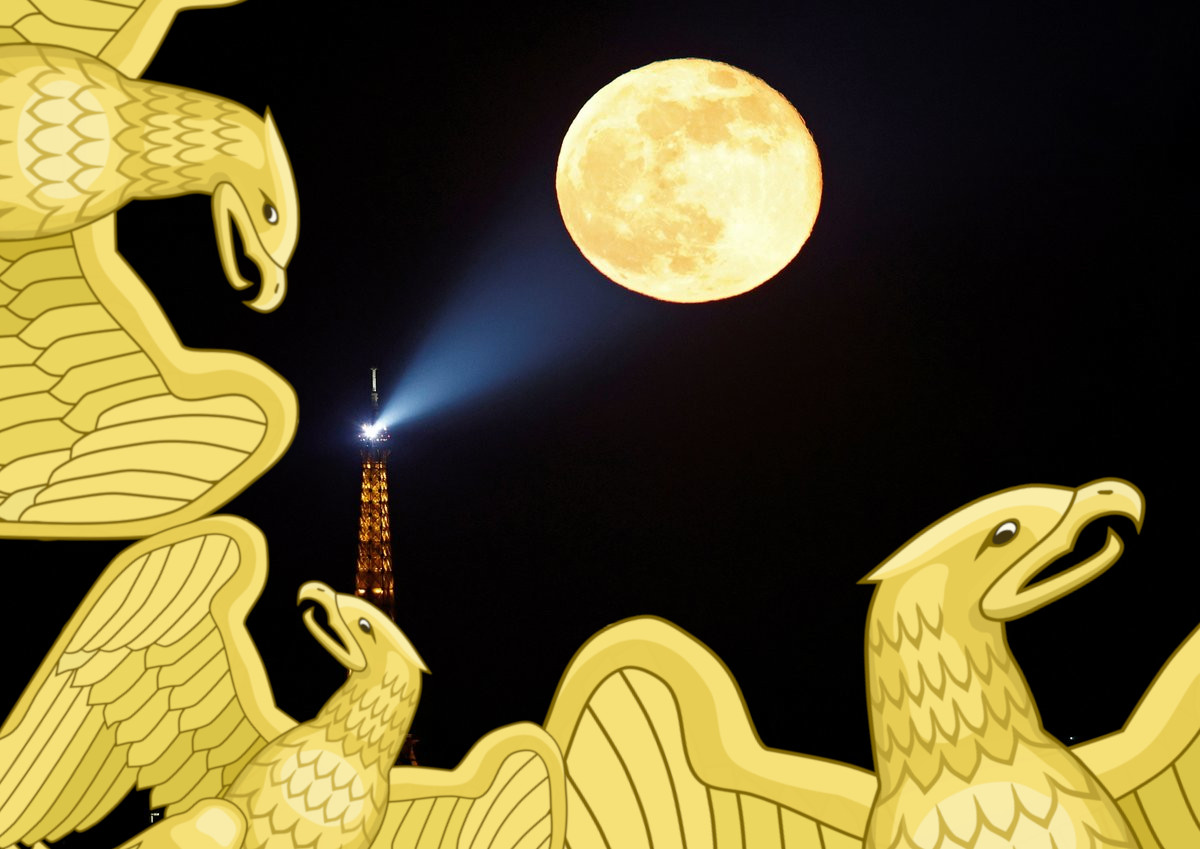
To make the whole three eagle moon situation worse, there were only four bloody infantry eagles in the entire guard anyway – the 1st and 2nd Chasseurs and Grenadiers had one each. No Eagles for anyone else – the Middle and Young Guard didn’t even have Tricolore flags, just fanions. The fanions are coloured, decorated and embroidered flags with a huge degree of barely described variation, used on a smaller scale than the regimental flags to provide rallying points, centres to pivot on and the coordination so vital to line-era infantry. Luckily, the team at GMB designs have everything needed – and with some chopping and sticking to correct some mistakes, I have all the flags in the right places.
To make this even more confusing, there’s differences in the composition of command groups that I didn’t even realise until it was time to decide what this article would be about. Regimental command groups are different to the Company and Battalion command groups, with different soldiers, flags, musicians and ranks. To make a Company command I need three Officers, one senior NCO, several NCOs, one of which carries a fanion, and two drummers. To scale that onto a command base of 6 figures under my scheme, that will be 1 Officer, 1 NCO, 1 Drummer and 1 fanion-bearer.
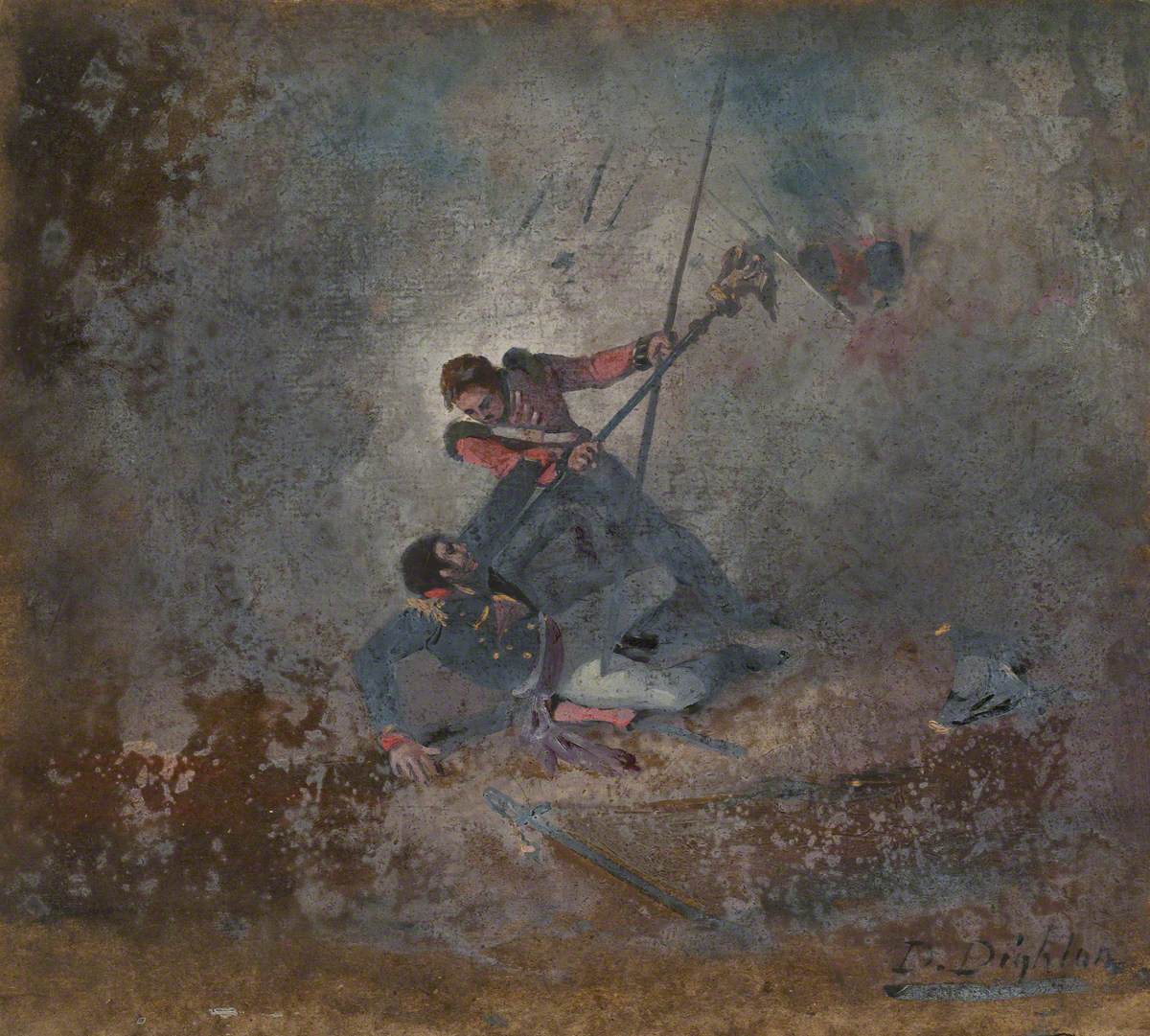
Dighton, Denis; The Capture of the French Eagle; Royal Society for the Encouragement of Arts, Manufactures and Commerce; http://www.artuk.org/artworks/the-capture-of-the-french-eagle-218521
For a Regimental command, it needs many more Officers, NCOs and Sappers, lots of drummers, a surgeon and the Eagle Bearer – with accompanying Eagle Guards. On the 6-man base, that’s whatever awesome models I have to hand, and enough to spread out over adjacent bases. The Eagle Guards I have so far are on the Velites of Turin command group – marking it out as a regimental command in a regiment that had neither eagle or eagle guards (oh well, they do now!). Luckily, there’s enough plastic left in the pile to whip up a company command for the Velites, which also then commits me to doing another unit of them – no great hardship there!
With a bit of rearranging, distributing models around the bases and the new flags I’ve got enough semi-decent looking command groups to put the large unit command question to bed – for now. Behold! Old Guard Chasseur Battalion and Section Command, Regimental Velites du Turin, and Battalion 2eme Tirailleur – and as much command as my skirmishing Flanquer-Chasseur unit will get.

Old Guard Chasseur Company NCOs with Fanion 
Some guy with an Eagle 
Chasseur Batallion Command 
Tirailleur Battalion Command 
Velites Regimental Command
Reading and Badass of the week
Reading and research never ends, planning never ceases and the inexorable takeover of my mind by a strange, intense, Corsican general continues. I took a break from the military reading to dive into the Rose of Martinique, a biography of Josephine by Andrea Stuart, which was a good tone and content shift from the last few very compensatory-dick-energy military histories. While I can’t say it’s the best historical biography I’ve ever read, and at this point skimming over the general intro-to-period-stuff is a must for me, it was enjoyable, clear and a good insight into an elusive figure. It’s very much a Josephine-by-context, looking at better known figures around her to establish what was going on. Between deliberate slighting and a surprising scarcity of her own letters (compared to the big N), there’s still a void of who the hell this woman actually was, so anything chipping away at that is to be commended. Josephine is done dirty by a lot of historians, and eventually by Napoleon, one of a litany of women in history reduced to a sex joke attached to their husbands, and this biography goes a long way to redressing that injustice.
We’re going to Spain for the badass award, and Don Cosme Churruca. If you’re listening along to the Age of Napoleon podcast at the moment, you’ll know this one from the recent Trafalgar episode. There’s a running theme in these of “people who don’t know when to surrender even when it’s clearly and objectively the only choice, and would in fact save hundreds of lives”, and it’s in that spirit that Churruca joins the Widow Brulon and Roguet. Churruca commanded the San Juan Nepomuceno at the Battle of Trafalgar, and steadfastly refused to surrender – one of the last ships on the allied French/Spanish side to still be fighting as the noose of ships slowly tightened. Even after losing his leg, he remained standing (sitting, possibly), refusing surrender and literally nailing the colours to the mast in defiance of the British, until his completely inevitable death.
Next time: I hate horses
Addendum: After writing all this, I realised the Guard – of course – would probably be totally different. Turns out they may have used completely non-standard sizes and unit composition, including the demi-company (half a company), with its own smaller section sizes. Smaller section sizes of……… 30-50 men. Je suis énervé. Extremely énervé.
Have any questions or feedback? Drop us a note in the comments below or email us at contact@goonhammer.com.

